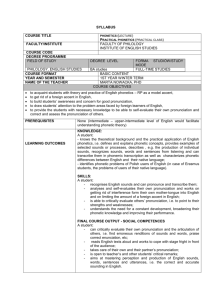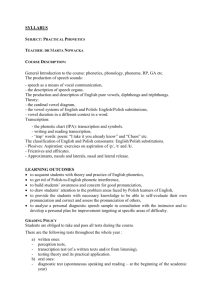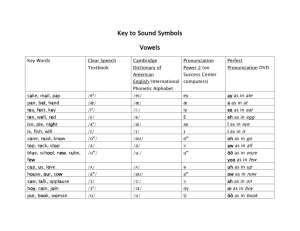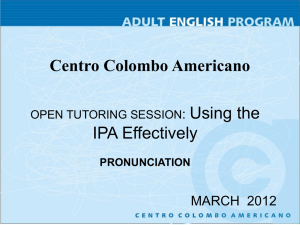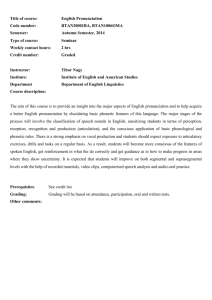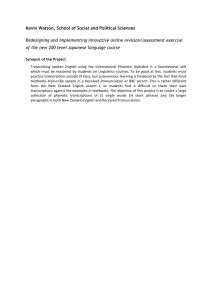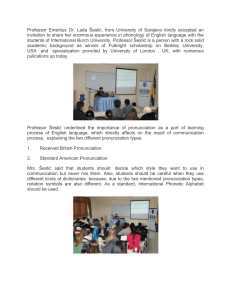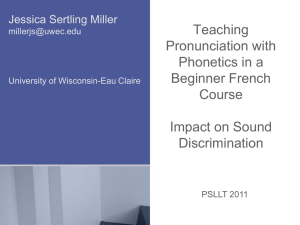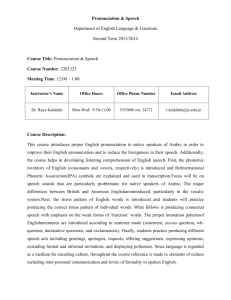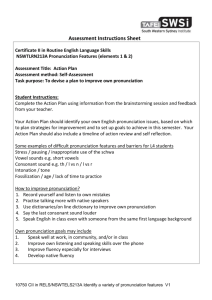SYLLABUS COURSE TITLE phonetics (lecture) Practical phonetics
advertisement
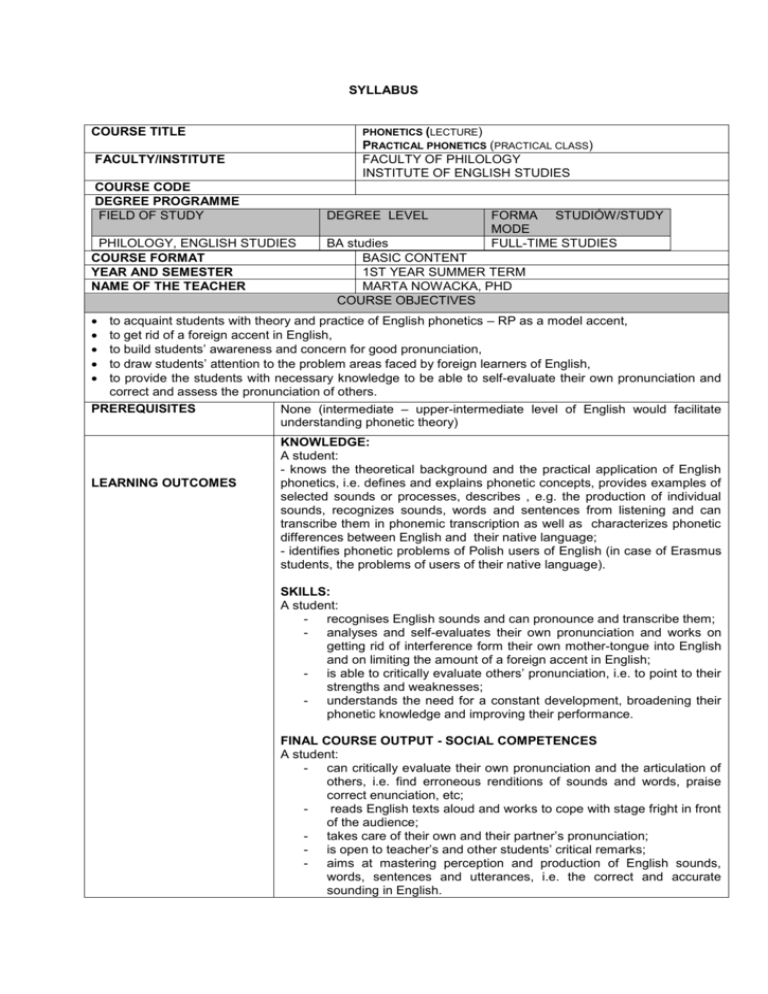
SYLLABUS COURSE TITLE PHONETICS (LECTURE) PRACTICAL PHONETICS (PRACTICAL CLASS) FACULTY/INSTITUTE FACULTY OF PHILOLOGY INSTITUTE OF ENGLISH STUDIES COURSE CODE DEGREE PROGRAMME FIELD OF STUDY DEGREE LEVEL PHILOLOGY, ENGLISH STUDIES COURSE FORMAT YEAR AND SEMESTER NAME OF THE TEACHER FORMA STUDIÓW/STUDY MODE FULL-TIME STUDIES BA studies BASIC CONTENT 1ST YEAR SUMMER TERM MARTA NOWACKA, PHD COURSE OBJECTIVES to acquaint students with theory and practice of English phonetics – RP as a model accent, to get rid of a foreign accent in English, to build students’ awareness and concern for good pronunciation, to draw students’ attention to the problem areas faced by foreign learners of English, to provide the students with necessary knowledge to be able to self-evaluate their own pronunciation and correct and assess the pronunciation of others. PREREQUISITES None (intermediate – upper-intermediate level of English would facilitate understanding phonetic theory) LEARNING OUTCOMES KNOWLEDGE: A student: - knows the theoretical background and the practical application of English phonetics, i.e. defines and explains phonetic concepts, provides examples of selected sounds or processes, describes , e.g. the production of individual sounds, recognizes sounds, words and sentences from listening and can transcribe them in phonemic transcription as well as characterizes phonetic differences between English and their native language; - identifies phonetic problems of Polish users of English (in case of Erasmus students, the problems of users of their native language). SKILLS: A student: - recognises English sounds and can pronounce and transcribe them; - analyses and self-evaluates their own pronunciation and works on getting rid of interference form their own mother-tongue into English and on limiting the amount of a foreign accent in English; - is able to critically evaluate others’ pronunciation, i.e. to point to their strengths and weaknesses; - understands the need for a constant development, broadening their phonetic knowledge and improving their performance. FINAL COURSE OUTPUT - SOCIAL COMPETENCES A student: - can critically evaluate their own pronunciation and the articulation of others, i.e. find erroneous renditions of sounds and words, praise correct enunciation, etc; reads English texts aloud and works to cope with stage fright in front of the audience; - takes care of their own and their partner’s pronunciation; - is open to teacher’s and other students’ critical remarks; - aims at mastering perception and production of English sounds, words, sentences and utterances, i.e. the correct and accurate sounding in English. COURSE ORGANISATION – LEARNING FORMAT AND NUMBER OF HOURS LECTURE: 30 HOURS PRACTICAL CLASS: 60 HOURS COURSE DESCRIPTION A. LP. 1. 2. 3. 4. 5. 6. 8. B LP. Lecture COURSE CONTENT The syllable: strong and weak syllables, consonant clusters. Word stress: in simple and complex words. Aspects of connected speech: - weak forms. - rhythm. - elision, assimilation, linking, juncture. Sentence stress. Tones in English. The form and functions of intonation. Final test TOTAL NUMBER OF HOURS PRACTICAL CLASS COURSE CONTENT NUMBER OF HOURS 1 3 5 1 2 2 1 15 NUMBER OF HOURS 4 1. Transcription: reading and writing phonemic symbols. Trap words, Poem: “Chaos,” weak forms, contracted forms etc. 2. Production and perception of English consonants. 8 3. Syllable, consonantal clusters, strong and weak syllables 2 4. Word stress: in simple and complex words. 2 5. Aspects of connected speech: 8 - weak forms. - rhythm. - elision, assimilation, linking, juncture. 6. Sentence stress. 2 7. Tones in English. 2 8. Tests 2 Total number of hours: 30 METHODS OF INSTRUCTION Lecture: PowerPoint presentation. Student’s individual work and pair-work in a language laboratory supervised by the teacher. Activities with a focus on perception and production. Types of exercises: individual and choral repetition drills, imitating the model pronunciation, minimal pairs, transcribing from listening (sounds, words and sentences), writing texts in phonetic transcription and reading transcription. Teacher and peer correction and self-evaluation. REQUIREMENTS AND Lecture: ASSESSMENTS 2 term: test and final written exam: close and open-ended questions (60% for a pass); credit. Practical class: The final grade is based on up to 4 practical transcription tests and student’ pronunciation. GRADING SYSTEM Students are obliged to take and pass all tests during the course. 60% is required for a pass. There are the following tests throughout the whole year : a) written ones: - perception tests, - transcription test (of a written texts and/or from listening), - testing theory and its practical application. b) oral ones: - diagnostic test (spontaneous speaking and reading – at the beginning of the academic year) - progress test (spontaneous speaking and reading – at the end of the academic year). To receive the credit it is important that the students: pass tests, attend the classes regularly (one absence i.e. two hours without the justification is acceptable) do regular home assignments, participate in the class activities in an active way. TOTAL STUDENT WORKLOAD NEEDED TO ACHIEVE EXPECTED LEARNING OUTCOMES EXPRESSED IN TIME AND ECTS CREDIT POINTS LANGUAGE OF INSTRUCTION INTERNSHIP MATERIALS Type of task Number of hours/ student’s workload 15 godz. 30 godz. 35 godz. lecture practical class preparation for a practical class teacher consultation 4 godz. preparation for a theory 15 godz. test and exam exam 1 godz. NUMBER OF HOURS 100 godz. TOTAL ECTS POINTS 4 ENGLISH N/A PRIMARY OR REQUIRED BOOKS/READINGS: LECTURE: 1. Roach, P. (1995) English Phonetics and Phonology: a Practical Course, Cambridge: Cambridge University Press 2. Sobkowiak, W. & Szpyra, J. (1995) Workbook in English Phonetics, Poznań: Nakom. PRACTICAL CLASS: 1. Mańkowska A., M. Nowacka, M. Kłoczowska. 2009. “How Much Wood Would a Woodchuck Chuck?”: English Pronunciation Practice Book, Rzeszów: Konsorcjum Akademickie. 2. Wells, J. C. (2000) Pronunciation Dictionary, Essex: Longman. SUPPLEMENTAL OR OPTIONAL BOOKS/READINGS: 1. Jones, D. (1997) English Pronouncing Dictionary, Cambridge: Cambridge University Press. 2. Nowacka, M. et al. (2011) Sally Meets Harry: Practical Primer to English Pronunciation and Spelling, Rzeszów: Wydawnictwo Uniwersytetu Rzeszowskiego. 3. Sobkowiak, W. (1996) English Phonetics For Poles, Poznań: Bene Nati.
